Last updated on 2025-12-07 at 18:09 EST (UTC-05:00)
From Sparks to Software: Reflections on Waves, Wavelengths, and the Spirit of Radio
Every so often, a class reminds me that the fundamentals never really change. This week’s topic — Waves, Wavelength, Frequency, and Bands — was a trip back in time for me. As someone who trained as an electronics engineering technologist in the 1980s, this material feels like old territory. Yet, revisiting it in today’s context, with modern software-defined radios (SDRs) and digital signal processing, highlights just how enduring these basic principles are.
The Timeless Language of Waves

The lecture opened with the essentials: amplitude, wavelength, and frequency — the vocabulary of every waveform, whether it’s a sound wave in air or a radio wave racing through space. Back then, we learned these on oscilloscopes with green phosphor traces, adjusting time bases and triggering circuits to freeze those elegant sine waves in time. Today, the same principles remain, but the scopes are digital, and the waves are simulated, captured, and analyzed by software.

Image: Inductiveload, Wikimedia Commons
What hasn’t changed is the relationship between wavelength and frequency — the beautiful simplicity of ( c = f \λ ), where the speed of light ties them together. It’s still the same 300 × 106 metres per second in free space, as it was for Heinrich Hertz when he first proved Maxwell’s equations right. The numbers might scale from kilohertz to gigahertz now, but the physics hasn’t changed a bit.
| Band Name | Abbr. | ITU band | Frequency | Wavelength |
|---|---|---|---|---|
| Extremely low frequency | ELF | 1 | 3–30 Hz | 100,000–10,000 km |
| Super low frequency | SLF | 2 | 30–300 Hz | 10,000–1,000 km |
| Ultra low frequency | ULF | 3 | 300–3,000 Hz | 1,000–100 km |
| Very low frequency | VLF | 4 | 3–30 kHz | 100–10 km |
| Low frequency | LF | 5 | 30–300 kHz | 10–1 km |
| Medium frequency | MF | 6 | 300–3,000 kHz | 1,000–100 m |
| High frequency | HF | 7 | 3–30 MHz | 100–10 m |
| Very high frequency | VHF | 8 | 30–300 MHz | 10–1 m |
| Ultra high frequency | UHF | 9 | 300–3,000 MHz | 100–10 cm |
| Super high frequency | SHF | 10 | 3–30 GHz | 10–1 cm |
| Extremely high frequency | EHF | 11 | 30–300 GHz | 10–1 mm |
| Terahertz or tremendously high frequency | THF | 12 | 300–3,000 GHz | 1–0.1 mm |
[13]
A Short History of Long Waves
Thinking about waves and bands always takes me back to the early history of radio — to the days of spark-gap transmitters, longwave Morse signals, and men like Hertz, Marconi, and Fessenden. Those pioneers were dealing with kilohertz frequencies, with antennas and capacitors the size of ships, yet they were manipulating the same invisible medium we use today.
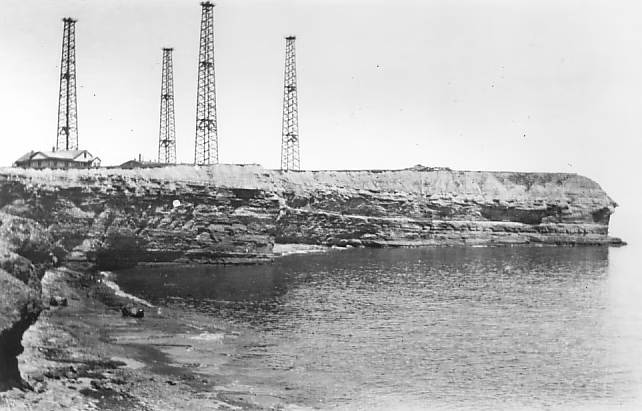
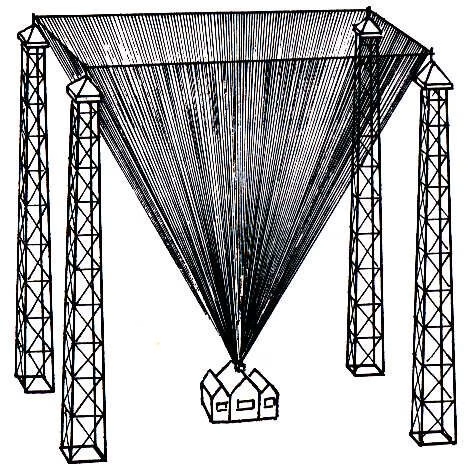
I’m pretty sure my neighbours would be unhappy with me if I built an antenna array that resembled Marconi’s Glace Bay installation!
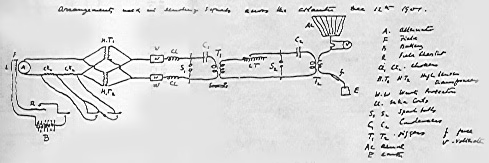
By 1907, the Marconi station at Glace Bay, Nova Scotia, was operating on remarkably low frequencies for its time — around 70 kHz. That range was chosen for the transatlantic service linking Glace Bay with Clifden, Ireland, inaugurated in October 1907.
Earlier experiments at the site had been conducted on higher frequencies — roughly 182 kHz in 1902 and 272 kHz for some later trials — but Marconi’s engineers soon discovered that lower frequencies provided far greater reliability over long distances. By 1907, they had moved down to around 70 kHz, and eventually as low as 45 kHz.
These very long wavelengths (VLF) proved ideal for transatlantic work. The signals could travel enormous distances, reflecting between the Earth and the ionosphere, and remained stable both day and night — something that higher frequencies of the day couldn’t achieve. Considering the limits of early transmitters and receivers, this was an extraordinary technical accomplishment and a milestone in the development of reliable global communication.
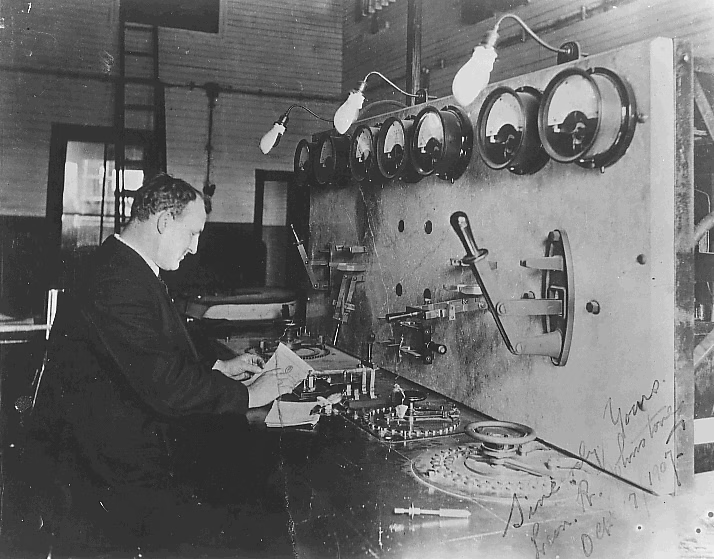
In the photo above, Marconi Operator L.R. Johnstone is shown transmitting the first official messages of the commercial wireless telegraph service from Marconi Towers, near Glace Bay, Nova Scotia, to Clifden, Ireland, on October 17, 1907. Ten thousand words were exchanged between the stations on the first day of operation.

image: Cape Breton Wireless Heritage Society
The rotary spark discharger was the heart of the spark transmitter at Marconi Towers. In the upper-right background, the three large ring-shaped loops are the three turns of the antenna transformer’s primary coil, which fed the spark’s electrical energy into the high-mounted antenna.
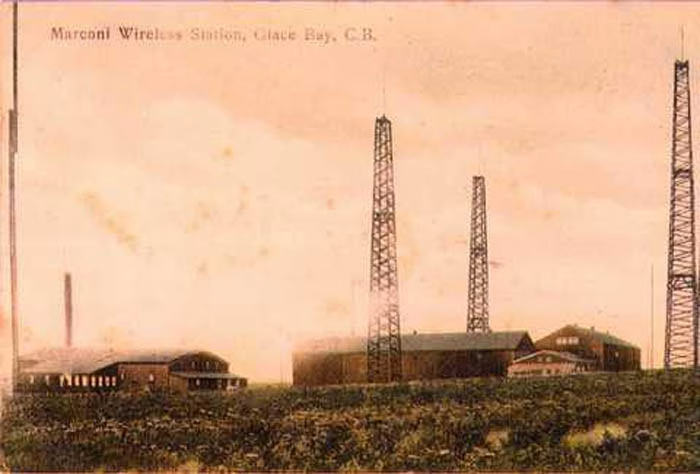
See page for author, Public domain, via Wikimedia Commons.
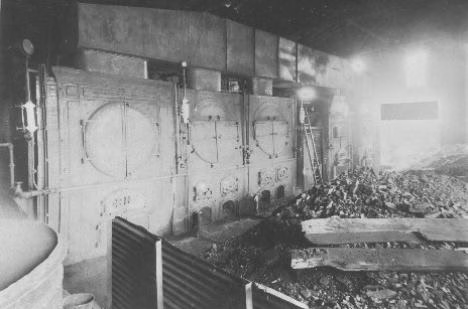
image: Cape Breton Wireless Heritage Society
At the Marconi station in Glace Bay, Nova Scotia, six steam boilers powered dynamos that generated the 15 kV power supply, which charged a capacitor composed of 288 metal sheets, each measuring 60 feet by 20 feet, separated by approximately 6 inches. The sheets were suspended from rafters at the top of the building and hung vertically almost to ground level. This capacitor (or “condenser,” as it was initially called) occupied most of the 160-foot-long transmitter building. As a result, the building became known as the condenser building.

Collection of Port Morien Station, ca. 1912 / Collection de la station de Port Morien, vers 1912.
This extensive array of plates offered only 1.7 microfarads of capacitance, with a voltage rating of 15 kilovolts. An “air-insulated” design was selected over a more compact glass dielectric design because it was relatively trouble-free and easy to build using locally available materials. If a draft caused the plates to shift and short-circuit, the “spot-welded” plates could be knocked apart with a sledgehammer.
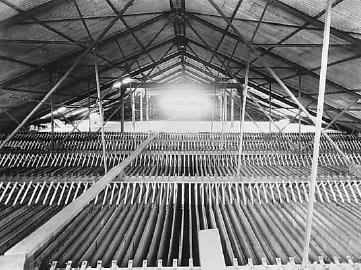
One story that sticks in my mind is Weather Station Kurt, a German automatic transmitter secretly placed in Labrador during the Second World War. It operated on 3940 kHz — smack in what we now think of as the amateur 80 m band — sending weather reports back to Germany every few hours. Even in wartime, radio’s reach was both strategic and scientific, and its physics — the propagation of electromagnetic waves through atmosphere and ionosphere — governed everything.
From Resonant Circuits to Software Radios

When I first learned about LC circuits, we tuned them with physical coils and capacitors, feeling resonance through the sound in a speaker or the flicker on a meter. The “bands” we talked about then — HF, VHF, UHF — were as much about practical limitations as they were about regulation. Antenna length, wavelength, and atmospheric reflection all dictated what was possible.
Today, when I look at a modern software-defined radio (SDR), I find it astonishing to think that an entire superheterodyne receiver now fits in a USB drive. Instead of a coil and a capacitor, we use algorithms to shift and filter signals in code. But the foundation — waves, frequencies, and harmonics — is the same. Whether it’s a spark-gap transmitter, a vacuum-tube superhet, or a LimeSDR, every one of them lives by the same electromagnetic laws.
Why It Still Matters
There’s a certain poetry in knowing that a 7 MHz signal — the classic 40 m amateur band — still bounces off the ionosphere just as it did when I first listened to shortwave broadcasts as a teenager. The gear has changed; the spectrum hasn’t. Even in a world dominated by Wi-Fi, Bluetooth, and cellular links operating in gigahertz ranges, it all still comes down to waves oscillating in time and space.
So while the students around me might be seeing this material for the first time, I find myself smiling at how familiar it feels. The math is old, the physics immutable, and yet the applications keep evolving. From sparks to software, from the hiss of AM static to the crisp digital decoding of an SDR waterfall, it’s all the same story — one wave at a time.
Looking Ahead
As the course continues, I’m looking forward to diving deeper into how these timeless wave fundamentals shape the communication technologies we rely on every day. Understanding them through both the lens of experience and modern tools like SDRs bridges the gap between the analog world in which I first learned and the digital systems that define today’s engineering practice. It’s a reminder that while technology evolves, the language of physics remains beautifully consistent — and that makes every new concept feel like an old friend revisited.
References
[1] Marconi – Krause House Info-Research Solutions
[3] List of Marconi wireless stations
[5] List of Marconi wireless stations – Wikiwand
[6] Frequency Spectrum Management Overview
[7] Radio’s First Message – Fessenden and Marconi
[8] An Historical and Technological Survey
[9] ULTRA TCS – Canadian Marconi History
[10] VE1DEW – Callsign Lookup by QRZ Ham Radio
[11] M. Rosano, “Throwback Thursday: Nazi weather station in Labrador”, Canadian Geographic. 2015. Available: https://canadiangeographic.ca/articles/throwback-thursday-nazi-weather-station-in-labrador/ [Accessed: 2025-10-16]
[12] ‘The First Transatlantic Wireless Stations in Cape Breton’, Cape Breton Wireless Heritage Society. Accessed: Oct. 13, 2025. [Online]. Available: http://www.cbwireless.ednet.ns.ca/cbwirelessp3.html
[13] Rajiv, ‘Radio Frequency Bands’, RF Page. Accessed: Dec. 07, 2025. [Online]. Available: https://www.rfpage.com/what-are-radio-frequency-bands-and-its-uses/


Leave a Reply